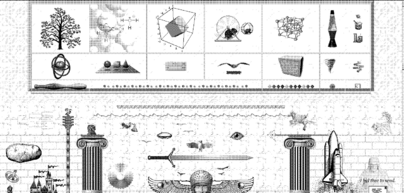_,.-'~'-.,__,.-'~'-.,__,.-'~'-.,__,.-'~'-.,__,.-'~'-.,__,.-'~'-.,__,.-'~'-.,__,.-'~'-.,__,.-

Across the web, hordes of self-organised internet communities find their sacred homes, tucked away from traditional online platforms. Hidden and occupying covert corners, these users reject the smooth corporate spaces in favour of porous DIY self-sustaining ones, where they are free to express themselves creatively with agency. Amongst their peers, users develop online languages, visual aesthetics, and digital folktales to connect and communicate their expression of self. Layered within low-tech tools, creative content is posted across forums (a great example can be seen at yesterweb.org), self-hosted servers, and open-source websites, as a way for users to distance themselves from the traditional stages of social media communication. Anonymity is favoured through the return of the use of avatars and screennames, thus expressing an alternative identity, one that cannot be achieved in AFK situations (Russell, 2020). The return of personal 'cosy' websites stands in place of plastic standardised design templates and harkens back to the homemade aspects of Web 2.0.
On the other side of the proverbial coin, generative AI (genAI) has firmly placed itself at the forefront of our digital landscape. Our feeds are inundated with machinic imagery and content made with Dall-E, Stable Diffusion, and countless others. Gathering content derived from the training data of large language models (LLM), these image generators use data scraped from across the web, stealing from average users and artists alike. However, this can often result in visuals more akin to Frankenstein’s monster, that or something so relentlessly bland, it becomes devoid of any meaning whatsoever. What we are left with are 'mean images' (Steyerl, 2023), "renderings which represent averaged versions of mass online booty, hijacked by dragnets" These so-called 'averaged versions' reinforce the plastic smoothness of the digital landscape (which you can explore further in Xenodataset by Esther Rizo Casado), removing any nuance or aspects of humanity (Boer, 2023) found in man-made creative expressions

But how can we construct more alternative narratives within AI? Could we glitch the system? Amongst the smooth, porousness can be found, and users will always uncover affordances within the software on offer. When websites could only handle text, and images were out of the realm of possibility, internet users created elaborate ASCII art to add a layer of visual elements to their personal pages. So what methods could be used to stretch the limits of genAI? Artists have already flocked to AI poisoning tools, such as the University of Chicago's Nightshade, to obscure their artwork within training data making renderings completely unpredictable. Other efforts include the open-source website haveibeingtrained.com which allows users to locate their data being trained within these LLMs which the American artist Beck Haberstroh has used to produce creative projects around identity and agency. We could also train our own image generators as a form of critique in the vein of Maya Man's Fake it 'Til You Make It project and reclaim autonomy among the smooth. What if we could gather all these hacks, and turn the bland outputs of AI image generators into a circular feed of reciprocity? This is the time to reintroduce some subversive spikes into our virtual lives.
_,.-'~'-.,__,.-'~'-.,__,.-'~'-.,__,.-'~'-.,__,.-'~'-.,__,.-'~'-.,__,.-'~'-.,__,.-'~'-.,__,.-
___________
|.---------.|
|| ||
|| ||
|| ||
|'---------'|
`)__ ____('
[=== -- o ]--.
__'---------'__ \
[::::::::::: :::] )
`""'"""""'""""`/T\